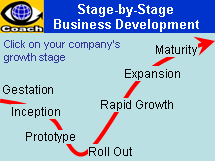|
7. |
Maturity
– the company is
established on the market; needs to innovate continuously to stay
competitive |
|
Organization:
Decentralized
Management: Professional
Technology:
Integrated Systems
Funding stage:
Asset-based |
|
pp. |
Problem
|
Solution
|
Action
|
|
7.1 |
Growth Risk
|
|
|
|
7.2 |
Innovation Risk
-
Shortening life cycle of
technologies and products
-
Incremental features of product
improvements add less and less value
-
Difficult, if not impossible, to
predict the next major trend in any industry
-
Rejecting an emerging technology
as it may be viewed as inferior to the corporate dominant technology
-
Elaborate approval processes
favoring slowed product development cycles
|
-
Continuous innovation
system
-
Intellectual
property management system
-
Management of
project portfolio and prioritization between projects
-
Top management
participation
-
Ability to adapt
quickly to changes in the marketplace
-
Culture
incorporating respect for company researchers, who should be linked to the
company's business objectives.
|
|
|
7.3 |
Marketing & Competing Risk
-
Growth rates and margins decline
as markets mature
-
Competitor's fierce reaction to
your global marketing campaign
-
Focusing attention to market
standing relative to the competition's only narrows the definition of the
market, leading the organization to ignore valuable market segments
-
Poor assessment of effectiveness
and profitability of various marketing channels
|
-
Continuous
market watch; anticipating the market needs
-
Maintaining and
defending market position
-
Developing new
market niches: seeking, expanding, global penetration
-
Reinventing
market
development strategy
-
Marketing
partnerships
|
|
|
7.4 |
Financial Risk
-
Sustained periods of negative cash
flow
-
No formal investment strategy
-
High risk of investment in
strategic research and venturing into new areas
-
High cost of building competitive
barriers
|
-
Operating costs
reduction through optimization of production systems
-
Shift from venture
capital towards asset based financing
-
Strategic research
cost sharing with alliances
-
Divesture of
segments
|
-
Look at several measures of
capital employment - not just one
-
Balance your risk capital
investments based on technology area, industry concentration, geography,
and other criteria
-
Work back to costs from what
customers are prepared to pay
-
Reduce inventory costs by
developing
lean production
systems
-
Explore opportunities for
attracting international financing and raising funds from public stock
markets
-
Explore opportunities for
managing projects as spinouts
-
Raise additional cash from
divesting from the low priority segments of your business
-
Enhance shareholder value by adopting a
leading-edge reporting model
-
Upgrade you expense control system
|
|
7.5 |
Team & Management Risk:
-
Reduced communication &
cooperation among functional units; poor
teamwork and coordination across
various functions of the company
-
Absence of integration for
business and systems plans
-
Turbulence due to expansion of the
managerial team
-
Changing focus; unclear strategy
or many conflicting priorities concerning what's going on in various
departments of the organization
-
A top-down or laissez-fair style
of leadership on the part of management that is either too autocratic or too
hands-off
-
Unhealthy competition for power; a
relative lack of leadership or managerial skills in the organization
-
Control systems poorly documented
-
Management fails to engage the
organization effectively
-
Measurements not related to
success factors
-
Reporting not tied to management
incentives
-
Poor vertical and horizontal
communication: employees don't know what top managers are thinking;
middle-level managers don't know what's going on in other departments
-
Highly structured reward schemes
do not motivate employees to be more innovative
|
-
Establishment of
management systems enabling better control, transparency, and customer
relationships
-
Development of
employee empowerment mechanisms
-
Development of
decentralized management structures, with managers operating within a
shared context that encompasses anticipation of future events that might
have an impact on the industry.
|
-
Create the mindset of growth
and establish the relentless growth
attitude in your organization
-
Establish
cross-functional management
system
-
Build a
process-managed enterprise and establish a
business process management system
-
Develop a holistic
performance management system
-
Practice
results-based leadership
-
Start with yourself,
know your own values, strengths, weaknesses and use them effectively;
practice
effective self-management,
systems thinking and
process thinking
-
Empower employees, vendors, customers, and peers to
measure your management performance
-
Delegate
authority;
define duties and
responsibilities according to current and future organizational
needs
-
To be a successful manager,
learn how to innovate; you have only two options – to
manage change
or to change management
-
Build an
innovation-friendly organization; devise catalytic mechanisms and
lead cycles of reinvention
-
Model
core
values; base your decisions on the values; and hold everyone
accountable to values
-
Find, develop and manage
people
partnerships
-
Reinvent or reengineer your
organizational structure and your methods of
motivating people
-
Do the
feedback
analysis as a
matter of course to build on your strengths
-
Gain really effective control by
measuring
performance
and conducting a comprehensive business audit
-
Redeploy management talents;
share
strategic leadership
with the team and hold your management team accountable for strategic
leadership
-
Be creative; nurture/champion
new ideas
-
Look for trends and opportunities
-
Never stop learning; build a
learning, teaching, and
coaching organization
-
Lead
others to achieve the corporate
vision, re-plan,
act and measure results; be proactive; seek timely
feedback
-
Help every individual to
find the right fit within the
business
-
Make sure you
communicate
clearly and often with colleagues, superiors, and subordinates
-
Play the role of the
team builder,
coach,
strategic planner
and
communicator; take
relationship
responsibility
-
Be explicit about what you
expect and what you won't tolerate
-
Design
reward system
to reflect
values
|

